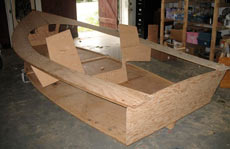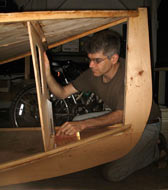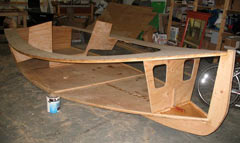There are many excellent books devoted to the “how-to’s” of boat building. I have copies of books by Phil Bolger, whose chatty self-deprecating style fired my early enthusiasm for building, and I dutifully ordered a copy of Dynamite Payson’s treatise on instant boat building once I decided to take the plunge. Along with the requisite subscription to Wooden Boat magazine and regular visits to Duckworks, I considered myself well prepared for the task of building a boat when I started working on my Stevenson Pocket Cruiser last March.
But despite my research and reading I quickly discovered that still didn’t know what it was really like to build a boat. While the books helped me understand, in broad strokes, how boats are constructed and introduced me to some key vocabulary, even the most detailed publications failed to convey the unique and—for me—vaguely disorienting experience of boat building.
 |
Despite my research and reading I quickly discovered that still didn’t know what it was really like to build a boat. |
I arrived at boat building with little experience as a sailor, but I did bring some limited skills as a woodworker and carpenter. I assumed that my familiarity with planes, circular saws, and c-clamps would prepare me for the task of banging together a small plywood sailboat. It’s all measuring and cutting, right?
Well, not exactly. Although woodworkers and boat builders both make sawdust, there are some important differences. Simple woodworking projects—the kind I usually undertake--are more like connect-the-dot exercises. Pieces can be precut and, if measurements are precise and the cutting true, parts for, say, a bookcase or shed come together with satisfying precision.
In contrast, I am quickly learning that boat building defies predictability. It is more of an art than a science, guided by eye and intuition as much as it is guided by tape measures and plans.
Most boats feature long curves and odd angles. As a result, small variations inevitably creep in while lofting, cutting, and assembling. This means that angles must be tweaked and pieces cut to fit at nearly every step. If the plans tell you to cut a deck fourteen feet long, but your boat needs a deck that is fourteen feet plus one inch, don’t panic and assume that you’ve made a terrible mistake (as I did). Believe experienced builders who tell you to simply add the inch and move on.
To their credit, Pete and Mike Stevenson, my boat’s designers, anticipated this concern and try to prepare first time builders for these alarming discrepancies in their introductory remarks about the boat building process:
“One thing we always tell beginner builders (that veterans learn the hard way) is that when you’re working from raw materials, things just don’t automatically fall together. Small variations sometimes add up on you rather than canceling each other out, and farther along in construction it’s better to recheck the dimensions on the actual boat against those in the plans, sizing the later parts to the parts already assembled rather than just following the dimensions in the plans.”
But it was a hard lesson to learn. When I first decided to build a boat, I promised myself that I would work with great care. Each cut would be exact, every measurement precise. I believed that if I simply read the instructions and followed each step to the letter the boat would fall together like a giant jigsaw puzzle. Every seam would line up; every angle would meet and match. It would be an exercise in Zen-like deliberateness: Chop wood, carry water, build a boat. Other people may make mistakes, but I’ll get it right the first time.
| It didn’t take long for fantasies of perfection to evaporate. Despite my care with measuring and cutting, joints gapped, angles were slightly off, and boards were either a quarter inch too long or too short. |
 |
It didn’t take long for fantasies of perfection to evaporate. Despite my care with measuring and cutting, joints gapped, angles were slightly off, and boards were either a quarter inch too long or too short. I started to approach each new cut with a sense of dread, consumed by a fear that I was making a hash of the whole project. Every time my measurements deviated from the plans, I wondered if I had made a fatal flaw. After the first month, I was sure my boat would look like a mess and go down as fast as a torpedoed Lusitania.
Worse yet, I panicked every time I couldn’t understand the instructions or clearly interpret the diagrams. The Stevenson’s provide clear and user-friendly instructions, but they can’t anticipate every question and not every step is discussed in detail. It was like someone turned out the lights every time I encountered a missing measurement or vague statement.
My worries reached a crisis stage when, after leading me by the hand through lofting and initial cuts, I could not, for the life of me, figure out how I was supposed to attach the deck to the top of the boat’s stem. The instructions simply told me to lift the deck in place and screw it down. But I knew that it was slightly more complicated than that. I clearly needed to prepare the stem in some way—it was too high and at the wrong angle—but I refused to act on my own.
I sent out a call to other Pocket Cruiser builders asking for help and heard back from several who recognized my confusion and offered helpful advice. But I also had a small epiphany when I realized that each person had solved the problem in a slightly different way—one cut a notch in the top of the stem, another used a simple butt joint, and so on. Yet each ended up with a solid, functional sailboat. Hmm, I said to myself, maybe there’s more than one way to build a boat. Maybe small differences don’t matter. Maybe my “mistakes” and alterations are just part of the process.
More experienced builders intuitively embrace this philosophy. Indeed some of my boat building acquaintances are constitutionally incapable of following plans and reject conformity outright. Tom Hoffman, who identifies himself as a “landlocked sailor in Iowa,” told me that he started with plans for a 17-foot Whitehall from Glen-L—which, by the time he was done, somehow ended up three feet longer. “So you see, I deviated quite a bit,” Tom wrote.
“I just thought it was part of the process. I never have been able to follow directions worth a hoot any way. The idea of taking Tab A and inserting into Slot B to get product C has never been in my vocabulary. Can't force myself to do it if my life depended on it.
I am constantly looking for a different (better) way. Sometimes I find it, sometimes not.”
I wish I had his confidence. Maybe I will after I finish another boat or two. But I am at least beginning to realize that boat building need not be—cannot be—a simple process of cutting and assembling. It’s more like jazz –open to interpretation and improvisation or, at least, small variation. Work with what you have.
 |
Boat building need not be a simple process of cutting and assembling. It’s more like jazz –open to interpretation and improvisation |
I found a small window into the unique culture of boatbuilding when I read The Saga of Cimba, which recounts author Richard Maury’s journey from Nova Scotia to the South Pacific on a 26-foot schooner in 1933. Maury didn’t dwell on his boat’s origins, but in the opening pages he did describe how a boat builder had constructed the Cimba “without so much as drawing a line on paper, or even whittling a model for a pattern. He had merely tacked together eight moulds, or life-sized cross sections, gauging them by eye, before immediately starting to build.”
My boat is more rudimentary than Maury’s traditional schooner, but there is a lesson here for me. Success does not result from microscopic analysis of the designer’s diagrams and instructions, but from a better appreciation of the big picture—and more faith in my own ability to solve problems.
I’m watching my building process evolve. After just four months of work, I find myself spending more time looking at the boat, and less time staring a the plans. I try to think ahead and anticipate the implications of each cut. I dry fit parts and give myself some wiggle room when cutting, knowing that I can trim a deck that is too long or knock an inch off the keel once everything fits. And I am trying not to worry about tiny gaps and other small discrepancies. As someone told me recently, “that’s what epoxy is for.”
It also helps to take the long view.
“In the long run we have to bear in mind that the water usually doesn’t care or even know about small variations,” the Stevenson’s write, “and you’ll soon forget all those nagging little discrepancies once the boat is shooting through the waves.” I’m sure they’re right and I almost believe them.
***********
|

